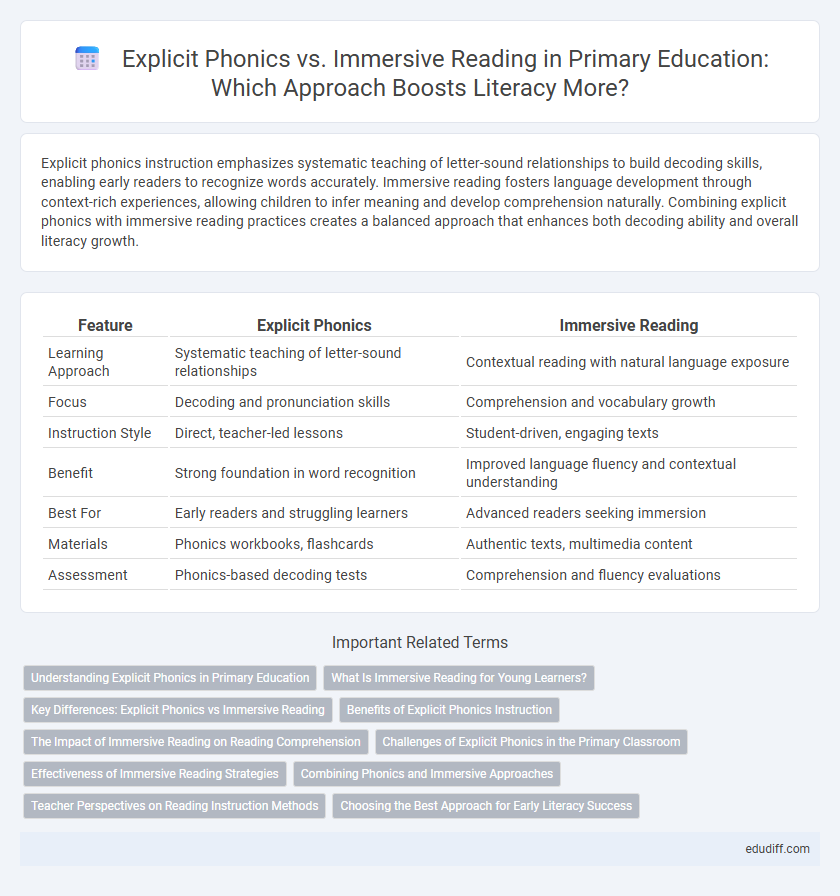Explicit phonics instruction emphasizes systematic teaching of letter-sound relationships to build decoding skills, enabling early readers to recognize words accurately. Immersive reading fosters language development through context-rich experiences, allowing children to infer meaning and develop comprehension naturally. Combining explicit phonics with immersive reading practices creates a balanced approach that enhances both decoding ability and overall literacy growth.
Table of Comparison
| Feature | Explicit Phonics | Immersive Reading |
|---|---|---|
| Learning Approach | Systematic teaching of letter-sound relationships | Contextual reading with natural language exposure |
| Focus | Decoding and pronunciation skills | Comprehension and vocabulary growth |
| Instruction Style | Direct, teacher-led lessons | Student-driven, engaging texts |
| Benefit | Strong foundation in word recognition | Improved language fluency and contextual understanding |
| Best For | Early readers and struggling learners | Advanced readers seeking immersion |
| Materials | Phonics workbooks, flashcards | Authentic texts, multimedia content |
| Assessment | Phonics-based decoding tests | Comprehension and fluency evaluations |
Understanding Explicit Phonics in Primary Education
Explicit phonics in primary education emphasizes systematic instruction in letter-sound relationships, enabling young learners to decode words with precision and build foundational reading skills. Research demonstrates that explicit phonics programs significantly improve early literacy outcomes, particularly in phonemic awareness and word recognition. This method contrasts with immersive reading approaches by prioritizing targeted phonics instruction to establish a strong decoding base before extensive reading practice.
What Is Immersive Reading for Young Learners?
Immersive reading for young learners integrates interactive text, audio, and visual aids to enhance comprehension and engagement, allowing children to decode meaning through context and sensory input. This approach supports language acquisition by combining listening and reading, which helps develop vocabulary, pronunciation, and fluency more naturally than isolated phonics instruction. Research shows immersive reading fosters stronger reading motivation and retention by creating a multisensory learning environment tailored to early childhood cognitive development.
Key Differences: Explicit Phonics vs Immersive Reading
Explicit phonics emphasizes systematic instruction in letter-sound relationships, enabling learners to decode words by breaking them down into individual phonemes. Immersive reading prioritizes contextual understanding and exposure to rich, meaningful text, encouraging natural language acquisition through continuous engagement with stories. The key difference lies in explicit phonics' structured approach targeting decoding skills versus immersive reading's focus on holistic comprehension and language immersion.
Benefits of Explicit Phonics Instruction
Explicit phonics instruction systematically teaches the relationships between letters and sounds, enhancing decoding skills crucial for early reading development. Research shows students receiving explicit phonics instruction demonstrate higher proficiency in word recognition and spelling accuracy compared to those relying solely on immersive reading. This method supports struggling readers by providing clear, structured guidance, ultimately improving literacy outcomes and building foundational language skills.
The Impact of Immersive Reading on Reading Comprehension
Immersive reading significantly enhances reading comprehension by engaging multiple sensory pathways, integrating visual, auditory, and tactile stimuli to deepen understanding. This method promotes cognitive connections between phonics and meaning, facilitating real-time decoding and contextual learning. Research indicates learners using immersive reading outperform peers in vocabulary retention and inferencing skills compared to those relying solely on explicit phonics instruction.
Challenges of Explicit Phonics in the Primary Classroom
Explicit phonics in the primary classroom often faces challenges such as limited engagement due to repetitive drills, difficulty addressing diverse learning paces, and insufficient emphasis on context for word recognition. Teachers may struggle to balance phonics instruction with the need to develop broader reading comprehension skills, resulting in fragmented literacy development. Furthermore, strict reliance on phonetic decoding can hinder students' ability to infer meaning from text, affecting overall reading fluency and motivation.
Effectiveness of Immersive Reading Strategies
Immersive reading strategies significantly enhance phonemic awareness and vocabulary retention by integrating contextual clues with multisensory engagement, facilitating natural language acquisition. Research indicates that immersive reading supports comprehension better than isolated explicit phonics instruction by promoting meaningful interaction with text. This approach leverages authentic language exposure, enabling learners to develop fluency and decoding skills simultaneously within a rich literary environment.
Combining Phonics and Immersive Approaches
Combining explicit phonics instruction with immersive reading fosters stronger language acquisition by integrating systematic decoding skills and contextual comprehension. Research indicates that blending phonics drills with meaningful, immersive texts enhances vocabulary growth and reading fluency more effectively than either method alone. This hybrid approach supports diverse learning styles, promoting both phonemic awareness and intuitive language use essential for literacy development.
Teacher Perspectives on Reading Instruction Methods
Teachers recognize explicit phonics as essential for foundational decoding skills, emphasizing systematic instruction in letter-sound relationships to support early literacy. Immersive reading is praised for fostering engagement and comprehension through context-rich experiences, enhancing vocabulary development and fluency in authentic texts. Educators often advocate a balanced approach, integrating explicit phonics with immersive reading to address diverse learner needs and optimize reading outcomes.
Choosing the Best Approach for Early Literacy Success
Explicit phonics instruction emphasizes systematic teaching of letter-sound relationships, which accelerates decoding skills essential for early reading proficiency. Immersive reading fosters natural language acquisition by engaging children in meaningful, context-rich text, enhancing vocabulary and comprehension. Selecting the best approach often depends on balancing the structured skill-building of explicit phonics with the contextual learning benefits of immersive reading to support diverse learning needs.
Explicit Phonics vs Immersive Reading Infographic

 edudiff.com
edudiff.com